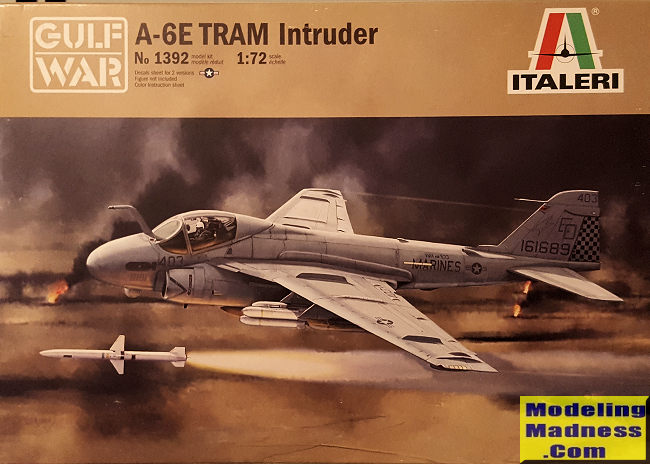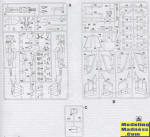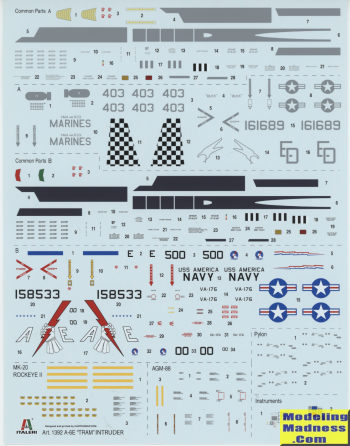
Italeri 1/72 A-6E TRAM Intruder
| KIT #: | 1392 |
| PRICE: | $16.98 |
| DECALS: | Two options |
| REVIEWER: | Scott Van Aken |
| NOTES: | 2017 release |

| HISTORY |
The definitive attack version of the Intruder with vastly upgraded navigation and attack systems, introduced in 1970 and first deployed on 9 December 1971. The earlier separate search and track (fire control) radars of the A-6A/B/C were replaced by a single Norden AN/APQ-148 multi-mode radar, and onboard computers with a more sophisticated (and generally more reliable) IC based system, as opposed to the A-6A's DIANE discrete transistor-based technology. A new AN/ASN-92 inertial navigation system was added, along with the CAINS (Carrier Aircraft Inertial Navigation System), for greater navigation accuracy.
Beginning in 1979, all A-6Es were fitted with the AN/AAS-33 DRS (Detecting and Ranging Set), part of the "Target Recognition and Attack Multi-Sensor" (TRAM) system, a small, gyroscopically stabilized turret, mounted under the nose of the aircraft, containing a FLIR boresighted with a laser spot-tracker/designator and IBM AN/ASQ-155 computer. TRAM was matched with a new Norden AN/APQ-156 radar. The BN could use both TRAM imagery and radar data for extremely accurate attacks, or use the TRAM sensors alone to attack without using the Intruder's radar (which might warn the target). TRAM also allowed the Intruder to autonomously designate and drop laser-guided bombs. In addition, the Intruder used Airborne Moving Target Indicator (AMTI), which allowed the aircraft to track a moving target (such as a tank or truck) and drop ordnance on it even though the target was moving. Also, the computer system allowed the use of Offset Aim Point (OAP), giving the crew the ability to drop on a target unseen on radar by noting coordinates of a known target nearby and entering the offset range and bearing to the unseen target.
In the 1980s, the A-6E TRAM aircraft were converted to the A-6E WCSI (Weapons Control System Improvement) version to add additional weapons capability. This added the ability to carry and target some of the first generation precision guided weapons, like the AGM-84 Harpoon missile, and AGM-123 Skipper. The WCSI aircraft was eventually modified to have a limited capability to use the AGM-84E SLAM standoff land attack missile. Since the Harpoon and SLAM missiles had common communication interfaces, WCSI aircraft could carry and fire SLAM missiles, but needed a nearby A-6E SWIP to guide them to target.
In the early 1990s, some surviving A-6Es were upgraded under SWIP (Systems/Weapons Improvement Program) to enable them to use the latest precision-guided munitions, including AGM-65 Mavericks, AGM-84E SLAMs, AGM-62 Walleyes and the AGM-88 HARM anti-radiation missile as well as additional capability with the AGM-84 Harpoon. A co-processor was added to the AN/ASQ-155 computer system to implement the needed MIL-STD-1553 digital interfaces to the pylons, as well as an additional control panel. After a series of wing-fatigue problems, about 85% of the fleet was fitted with new graphite/epoxy/titanium/aluminum composite wings. The new wings proved to be a mixed blessing, as a composite wing is stiffer and transmits more force to the fuselage, accelerating fatigue in the fuselage. In 1990, the decision was made to terminate production of the A-6. Through the 1970s and 1980s, the A-6 had been in low-rate production of four or five new aircraft a year, enough to replace mostly accidental losses. The final production order was for 20 aircraft of the SWIP configuration with composite wings, delivered in 1993.
A-6E models totaled 445 aircraft, about 240 of which were converted from earlier A-6A/B/C models.
| THE KIT |
 Italeri originally released the A-6E in 1994, followed by the EA-6A a year
later and the KA-6D four years after that. Both the A-6E and KA-6D have since
been reissued, though the EA-6A has not. This is the third release of the A-6E.
Italeri originally released the A-6E in 1994, followed by the EA-6A a year
later and the KA-6D four years after that. Both the A-6E and KA-6D have since
been reissued, though the EA-6A has not. This is the third release of the A-6E.
The tooling as all one would expect from a modern kit, with engraved panel lines, a nice selection of weapons and fairly nicely done interior. The cockpit is nicely done with a pair of bang sticks and some other bits. Rudder pedals are molded in place, which is fine for 1/72. The instrument panels and consoles have raised detail and the modeler needs to paint these as decals are only provided for the main panel, even though these decals are not indicated in the instructions.
Typical of these sorts of planes, the fuselage is in four sections. There are two halves with a piece that fits between the engines and a piece for the tail hook well. You are provided engine compressor faces for the exhaust, with this piece acting as a bulkhead as well. A similar approach is made to the intakes.
The kit is designed so you can fold the wings. As such, you need to install the inner stubs after opening the pylon holes should you decide to use them. Speed brakes are separate, but are designed to be closed as this feature was removed from all but the earliest A models. Intakes and exhaust are then attached to the fuselage along with the tail planes and radome. Note that 20 grams is required to prevent tail sitting. This is a lot of weight, but there seems to be room for it. You can also pose the boarding ladders up or down.
 Though I'd wait until later, Italeri wants you to install the canopy and
windscreen bits at this time. Then one deals with the landing gear, which is
nicely done. Note that only one of the two markings options has the FLIR pod so
keep this in mind during construction. For weapons you have bluster bombs on a
MER, an AGM-45 HARM missile and a fuel tank for the centerline. Is is only now
that the airframe is almost complete than you do the outer wings. Again, these
can be folded if you wish. If you want straight wings, I'd suggest doing this
before installing the inner wing stubs so you can have it all properly aligned.
Though I'd wait until later, Italeri wants you to install the canopy and
windscreen bits at this time. Then one deals with the landing gear, which is
nicely done. Note that only one of the two markings options has the FLIR pod so
keep this in mind during construction. For weapons you have bluster bombs on a
MER, an AGM-45 HARM missile and a fuel tank for the centerline. Is is only now
that the airframe is almost complete than you do the outer wings. Again, these
can be folded if you wish. If you want straight wings, I'd suggest doing this
before installing the inner wing stubs so you can have it all properly aligned.
Instructions are nicely drawn and offer Italeri Acrylic paint references. The fairly large decal sheet includes weapons markings and the walk areas in two colors. Markings are for the box art plane with VMA-533 in 1992, painted in the tactical paint scheme, and a VA-176 aircraft in 1976 without the FLIR in light gull grey over white. Kit decals are well done and if you don't like them, there are always aftermarket.
| CONCLUSIONS |
Over the years, there have been several A-6E kits produced. The best was the Fujimi kit, though difficulty in finding one and the newer tooling of the Italeri kit has made this one the 'go to' kit for Intruder modelers. Both this and the Fujimi kit (if you have one), will look great on your display shelf.
| REFERENCES |
https://en.wikipedia.org/wiki/Grumman_A-6_Intruder
July2021 Copyright ModelingMadness.com. All rights reserved. No
reproduction in part or in whole without express permission. If you would like your product reviewed fairly and fairly quickly, please
contact
the editor or see other details in the
Note to
Contributors.